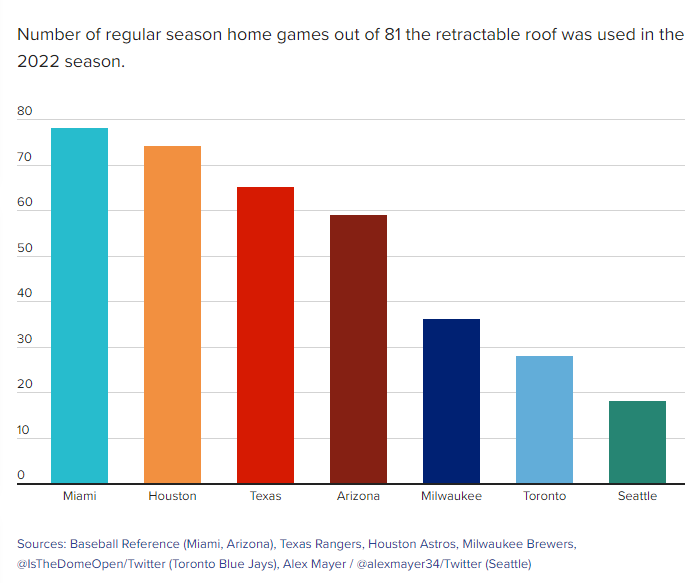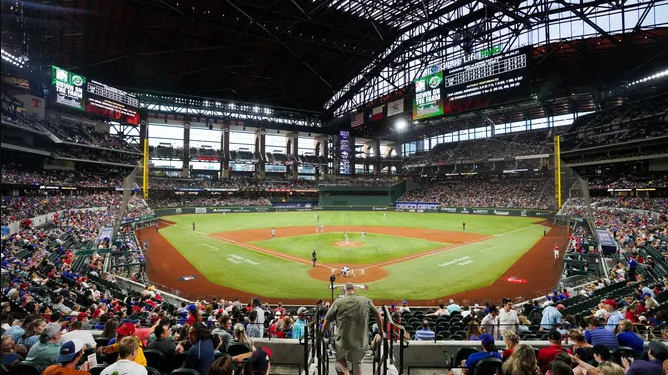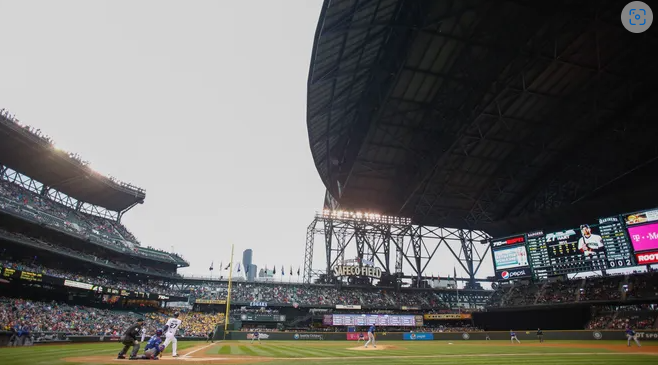10:45 AM | *Retractable roof usage in big league baseball is weather-dependent and some of the findings are surprising*
Paul Dorian
The Miami Marlins closed their stadium’s retractable roof more than all of the others in 2022 and Seattle had the fewest games played with the rood closed. (Credit Fox Weather )
Overview
There is one stadium in Major League Baseball (MLB) with a permanent roof and seven stadiums now feature retractable roofs. Retractable roof usage is weather-dependent and some of the findings from the past full season are surprising. In addition to precipitation, the decision as to whether to close a retractable roof may depend on local temperature, wind or humidity levels.
Details
There are now seven stadiums in the MLB that feature retractable roofs in the following locations: Seattle, Milwaukee, Toronto, Miami, Houston, Arlington (Texas), and Phoenix, Arizona. The most recent addition to this list came in 2020 at Globe Life Field in Arlington, Texas, home of the Texas Rangers. The other sites in the list include the first stadium with a fully retractable roof at the Rogers Centre in Toronto, Canada (opened 1989), Chase Field in Phoenix (1998), T-Mobile Park in Seattle (1999), Minute Maid Park in Houston (2000), American Family Field in Milwaukee (2001) and Loan Depot Park Stadium in Miami which opened up in 2012. (Note, several of these stadiums have different names from their opening days).
Conventional thinking would likely lead one to believe that the most used retractable roofs would be in the rainiest climates of these seven locations, but the findings from 2022 suggest otherwise with the most used actually in the sunnier sites. Seattle is the most rained-on city with a retractable roof, but it’s roof turned out to be the least closed of all during the 2022 season. The four stadiums in the southern US including Miami, Houston, Texas and Arizona where they battle summertime heat and humidity actually had their roofs closed more so than the three northern sites of Milwaukee, Toronto and Seattle…and in some cases, considerably more.
A general view of fans in the stands during the game between the Texas Rangers and the Kansas City Royals at Globe Life Field on June 25, 2021 in Arlington, Texas. (Credit: Alex Bierens de Haan / Getty Images/Fox Weather)
In Miami, for example, where they not only battle summertime heat and humidity, but also a daily threat of showers and thunderstorms, the roof was closed for all but 3 games in 2022 and two games in the preceding year. In Houston, the roof at Minute Maid Park was closed for 73 of its 81 home games in 2022 and, not far behind, the Texas Rangers had their roof closed for all but 16 home games in 2022. In Arlington, they tend to use 85 degrees as a loose barometer in their decision to close the roof and they also factor in humidity and wind as well. In Arizona, while not as humid as the other southern sites, there is triple-digit heat during much of the summer season. In 2022, there were 22 home games with the roof open in Arizona and these were mainly played early and late in the season. In fact, these southern US retractable roof stadiums play most of their “roof open” games in the months of April and September when the heat and humidity generally is lower compared to the summer season.
Up north, the decision as to whether to close the roof or not can be impacted by snow; especially, during the month of April in Milwaukee and Toronto. In Milwaukee, precipitation, temperature and wind are all factors in the decision-making process and the 2022 season saw a pretty even mix with 45 games played under an open roof and 36 games played indoors. In Toronto, the stadium’s roof was only closed for 28 games in 2022 or roughly one-third of the total number of home games.
The roof slowly closes as rain begins to fall during the game between the Seattle Mariners and the Texas Rangers at Safeco Field on April 26, 2014 in Seattle, Washington. (Credit: Otto Greule Jr. / Getty Images/Fox Weather)
And in Seattle, perhaps contrary to popular opinion, the roof was closed less than all other retractable roof stadiums with only 14 (full) games in 2022 and 10 (full) games in 2021 (there were a handful of games in these two seasons where the roof was closed for part of the game). Since the retractable roof stadium opened in Seattle in 1999, they have closed the roof an average of about 17 games per season according to a Mariners spokesperson. By the way, while Seattle does feature frequent rain events in the fall and winter, the late spring and summer are usually quite dry with the city averaging only about an inch of rain in July and August. The Seattle stadium is somewhat unique in its retractable roof in that extending the roof does not enclose the stadium, but rather just covers the field-of-play. In other words, the stadium is not temperature controlled so the decision as to close or not is not really dependent on the temperature as in other retractable roof locations.
A few final tidbits of information…
The very first retractable roof stadium was the Civic Arena in Pittsburgh, Pennsylvania which opened up in 1961 and was never intended for baseball. The very first domed stadium was the Astrodome in Houston, Texas with play beginning there in 1965. The Astrodome (now called the NRG Astrodome) was dubbed the “Eighth Wonder of the World” in its beginning days and is still standing today, but virtually idle. The Tampa Rays play in baseball’s only permanent roof stadium today known as Tropicana Field.
To find out ahead of time if a particular ballpark will have its roof open or closed, Twitter can be a good source of information. In particular, the following Twitter feeds will provide roof status:
Miami: @loanDepotpark, Blue Jays: @Is the Dome Open, Texas: @Globe Life Field Roof
For Milwaukee Brewers home games, one can simply call the “roof hotline” at 414 902 4636.
For the Houston Astros, go to this web site: astrosroof.mlblogs.com and for the Diamondbacks visit https://www.mlb.com/dbacks/ballpark/information/roof .
Finally, there is talk that the Oakland Athletics will make a move to Las Vegas, Nevada - perhaps in time for the 2027 baseball season. If the move proceeds as planned, the A's will become just the second Major League Baseball franchise to move cities in more than 50 years with the other being the Montreal Expos to Washington, D.C. in 2005. The first big step in this process of moving by the A’s has been made with the agreement by the team to purchase about 50 acres of land for a possible new stadium in Las Vegas later this decade just to the west of the Las Vegas Strip. And yes, the new stadium is planned to feature a partially retractable roof which would add to the list potentially giving 8 of the 30 big-league stadiums the ability to play indoors depending on local weather conditions.
Meteorologist Paul Dorian
Arcfield
arcfieldweather.com



